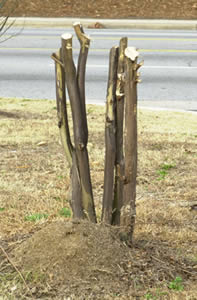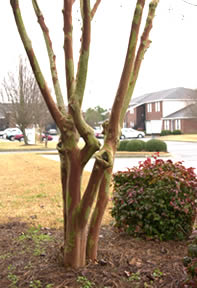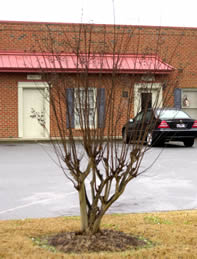
 |
|
| Crapemyrtles achieve an elegant natural form if left alone. |
Stop
the Crape Murder!
By Greg Grant
Edited by Doug Boyd
Hideous crimes are being committed all over Texas (and in North Carolina), some in our own front yards and many right in front of our local businesses. Unfortunately, many have turned a blind eye to the ongoing massacre.
Not me! I can take it no more. I am officially forming an advocacy group for plant's rights. They can't speak, so I'm going to speak for them. My first mission…to stop Crape Murder!
Lagerstroemia indica: the crapemyrtle. A native of China. The "Lilac of the South." The most popular flowering tree in the southern United States. Introduced by Frenchman Andre Michaux to South Carolina around 1786. Perhaps the most beautifully branching flowering tree in the world. Crapemyrtles are among the toughest, most adaptable and showiest plants we can grow in our landscapes. They have very few pests. They bloom all summer long. They require no supplemental irrigation. They have exfoliating bark that reveals spectacular smooth trunks. And they happen to have a branching structure that any floral designer would crave.
They pretty much do every thing but mow the lawn for us. But for some reason, a mysterious reason that I haven't quite solved, the majority of the "gardeners" (and ALL of the landscape crews) in Texas (and North Carolina) have made it a horrid ritual of butchering them.
Clip this article and take it directly to your spouse, maintenance person or nurseryman. I know of NO educated horticulturist or arborist who endorses the practice of topping crapemyrtles or any ornamental trees for that matter. Go ahead. Pick up the phone. Call Bryce Lane. Call Neil Sperry. Call Dr. Bill Welch. Call the National Arboretum! You WILL NOT find any plant expert that will condone or recommend this practice.
Then why do we do it? Actually I have several theories. But I'm not going to share any of them with you for fear that you might some how feel justified in your arboreal disfigurement. I will tell you why not too, however.
 |
|
| Someone should have spent less time hacking the top off this crapemyrtle and more time treating the fire ant mound at its base. |
First, it leaves horrible scars and wounds that last forever. That's correct, FOREVER. I can show you exactly where any crapemyrtle on earth was topped. It's a "teenage tattoo" that can never be removed. It also makes a profusion of smaller branches resulting in a lack of proportion. All trees have a characteristic shape. It just so happens that crapemyrtles have one of the most beautiful. Topping does create larger blooms, though fewer of them. Unfortunately these larger blooms on new shoots have a tendency to flop over and droop after summer rains. Sometimes, they cause their branches to break. And finally it's downright ugly.
We don't hack on dogwoods, redbuds or Japanese maples. So why do we pick out the prettiest one of all to maim? Surely it's not a "school girl" jealousy thing. How sick can we be to pick out the prettiest belle at the ball and scratch her face? This practice may look appropriate behind a chain link fence in a Mississippi trailer park, but I can assure you it is not appropriate for any landscape that you intend to be admired. Some of the most beautiful homes in Texas are now marred by embarrassing crapemyrtles. On the other hand, take a trip to Baton Rouge, Mobile, or Charleston. They have an enduring admiration for their beautiful crapemyrtles and wouldn't think of undoing what nature has perfected.
 |
|
| Though years of corrective pruning have helped this crapemyrtle regain a near-normal shape, deformities left by a long-ago topping are still evident. |
The only pruning crapemyrtles require is to thin trunks on young trees leaving three to seven permanent trunks. The fewer you have, the more you can admire their shape and smooth texture. Each year around early spring, all you do is remove any new suckers that appear from the ground or from the main trunks. That's it.
Yes, if the tree is small you can remove the seedpods, but realize that this is purely for aesthetic reason. Removing dried pods during the winter doesn't promote more blooms during the summer. Removing them during the summer does promote faster rebloom however.
This nonsense of pruning back to pencil-size wood comes from recommendations from the 1960s and is outdated. People apparently had a lot more free time then. There's no telling how many thousands of dollars are wasted on incorrect pruning of crapemyrtles. To be honest, an unpruned crapemyrtle is almost always superior in appearance to a "professionally" pruned one. Some things in nature are hard to improve on. In my personal opinion, any landscape maintenance firm involved in this practice should be immediately fired! They are wasting your time and money and obviously don't care what's best for your plants or your landscape. If they took the time to educate themselves through seminars and reading, they would earn your money through more horticulturally sound practices.
 |
|
| After topping, crapemyrtles grow back denser and obscure visibility more than if they had been left alone. |
I'm sure the few of you left reading this soapbox diatribe can't wait to tell me what many have in the past: "But Greg, they got too big!" Much better to cut them to the ground and start over or pull them out entirely than to maim them.
Most folks don't realize (but should) that many, many cultivars of crapemyrtles have an ultimate height of 3 to 30 feet. For heaven's sake, don't plant a 30-foot crapemyrtle in a space designed for a 10-foot one. Check with a reputable nursery. If a tree type is too large, many smaller types are available, including mildew-resistant ones. There are a number of improved semi-dwarf cultivars in the 6-to-8-foot range, including Acoma (white), Hopi (pink), Tonto (fuchsia) and Velma's Royal Delight (purple) that make outstanding small trees. Trees that NEVER need topping, that is.
Articles on this subject have appeared in Southern Living,
Neil Sperry's Gardens and other southern magazines and newspapers.
Unfortunately, the problem seems to be getting exponentially
worse each year. I can
only assume that gardeners in Texas (and elsewhere) either don't
read or don't care. Please prove me wrong.
Greg Grant is a horticulture lecturer at Stephen
F. Austin State University in
Nacogdoches, Texas, co-author of The Southern Heirloom Garden,
a master Texas certified nurseryman and
a member of the Garden Writers Association of America, the Southern
Garden History Society and the Lagerstroemia Jihad.
Boyd Landscaping
Winterville, NC 28590
252-814-8495
E-mail Boyd Landscaping
